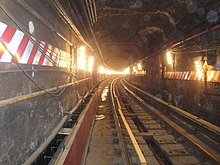
Back Steinway-Tunnel German Túnel Steinway Spanish Steinway Tunnel French スタインウェイ・トンネル Japanese Steinway Tunnel Dutch
 A view of one of the tubes in the Steinway Tunnel in February 2013 | |
| Overview | |
|---|---|
| Line | IRT Flushing Line (7 and <7> trains) |
| Location | East River between Manhattan and Queens in New York City |
| System | New York City Subway |
| Operation | |
| Opened | June 13, 1915[1] |
| Operator | Metropolitan Transportation Authority |
| Technical | |
| Length | 1.3 miles (2.1 km) |
| No. of tracks | 2 |
The Steinway Tunnel is a pair of tubes carrying the IRT Flushing Line (7 and <7> trains) of the New York City Subway under the East River between 42nd Street in Manhattan and 51st Avenue in Long Island City, Queens, in New York City. It was originally designed and built as an interurban trolley tunnel (with a narrow loading gauge and height), with stations near the current Hunters Point Avenue and Grand Central stations.
Planning for the tunnel began in 1885 but construction did not start until 1892 due to a lack of funds. The Steinway Tunnel was named for William Steinway, who provided the funding to start the initial construction. Steinway died in 1896 before the tunnel was completed, and the project sat dormant for several years, before the Interborough Rapid Transit Company (IRT) acquired the tunnel. The IRT resumed work in 1905 and completed the tubes in 1907 and was briefly opened for trolley service that September. Due to legal disputes, the tubes closed within a week and did not reopen for another eight years.[2] After the Dual Contracts were signed in 1913, the IRT began converting the tubes to subway use, and the tubes opened as part of the Flushing Line in 1915. In subsequent years, specific rolling stock were ordered to navigate the narrow dimensions of the tubes, and the tunnel suffered from numerous floods and fires.
© MMXXIII Rich X Search. We shall prevail. All rights reserved. Rich X Search